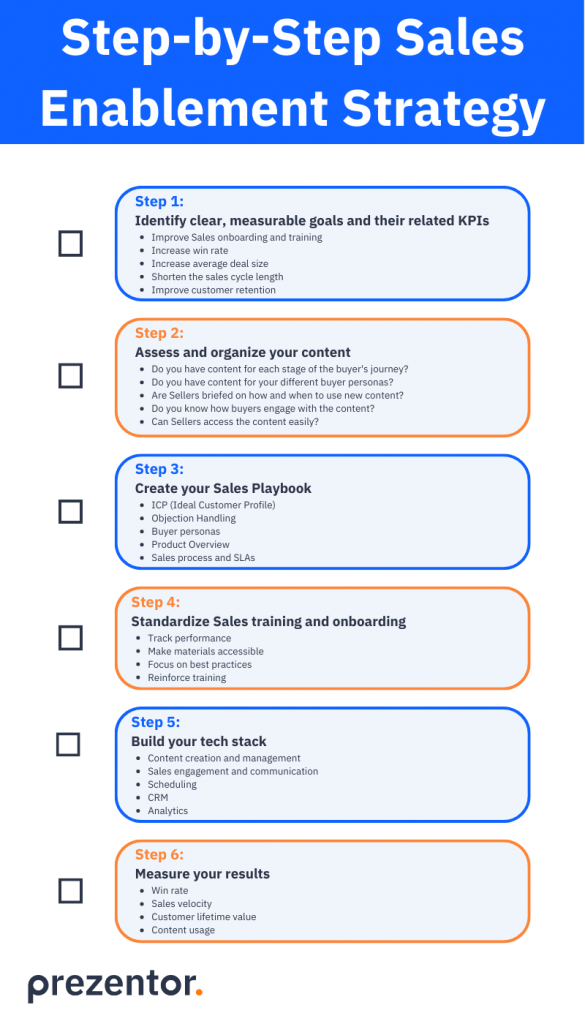How to build a Sales Enablement Strategy
Creating a sales enablement strategy is one of the very first actions to take when getting started with sales enablement. A successful sales enablement strategy can greatly improve the customer experience and make sellers’ job much easier. Data from Learn hub reveals that organizations with a focus on sales enablement achieve a 49% win rate on forecasted deals, compared to 42.5% for those without. With a strong sales enablement strategy, you can align sales and marketing, thus increasing efficiency and maximizing consistency in your communication with clients and prospects.
In this article, we will outline the elements of a sales enablement strategy and provide you with a step-by-step guide to create and implement your own strategy easily.
What are elements of a Sales enablement strategy?
Sales process design
One of the goals in creating a sales enablement strategy is to design and/or optimize your organization’s sales process. The sales enablement leader needs to create a sales enablement playbook with best practices and processes for sellers to follow, and ensure its adoption across the whole team. This maximizes consistency in the way your sales force sells and in their communication with buyers. It will also empower sellers with the knowledge they need to sell with confidence and focus on winning deals.
A consistent Sales process design also enables you to define and agree on SLAs (Service Level Agreements) across the organization. The SLAs can include a specific time frame when a new MQL should be assigned to a Sales rep, when a new lead should be contacted, and so on. This gives your organization the ability to provide prospects with a great buying experience, and increases transparency throughout the Sales process.
Asset creation and management
Sales enablement assets are all the pieces of content created and used to facilitate selling. These can be digital or physical, and include dynamic presentations, brochures, case studies and testimonials, ROI calculators and quotes, scripts for sales calls, and much more.
When creating a sales enablement strategy, it is important to ensure that sellers have access to relevant assets whenever and wherever they need them, so they can engage buyers, showcase product value, and sell effectively and efficiently.
Additionally, all Sales enablement assets should be created with the goal to inform and convert buyers by helping them to gain more understanding of your product and its benefits. It’s important that the assets align with the buyer journey and address the questions buyers typically have throughout their journey.
Sales enablement technology
In an increasingly digitalized world, you cannot sell without the right technology. Nowadays, it’s not just the customers who prefer virtual experiences – according to Gartner, fully virtual workspaces are growing in popularity, as employees demand flexibility over where and how to work.
When creating a sales enablement strategy, consider if you need to invest in new technologies that could improve your sales process not just for prospects but also for sellers.
Sales training and learning
A sales enablement strategy should outline a standardized training program and provide easy access to learning materials. The goal is to reduce the time it takes for new hires to get up to speed and be fully productive, and to ensure that sellers are kept updated on product features, best practices, new sales materials, and so on.
Assessment
Creating a sales enablement strategy is not enough – you should make sure you track and measure your results against your goals, to see if your strategy is being effective or if it needs adjustments. Keep an eye on the KPIs that are relevant to the goals you set, track buyers’ engagement, and follow your sales team closely to identify any lack of adoption and areas of improvement, so you can provide customized coaching where needed.
Creating a Sales enablement strategy step by step
Step 1: Identify clear, measurable goals and their related KPIs
A sales enablement strategy needs to be built with clear and measurable goals in mind. Making sure you know which metrics to track from the get-go will make it easier to see the results and can give you early warnings if something is not working out.
Here are some examples of common goals that can be achieved through a good sales enablement strategy, the advantages they bring, and the KPIs to measure them.
1. Improve Sales onboarding and training
Advantages: Increased new hire retention, reduced hiring costs, higher productivity
KPIs: Time needed for new hires to reach the same targets as their peers, eNPS, employee turnover
2. Increase the win rate
Advantages: Increased revenue, increased ROI on marketing investment, increased sellers’ confidence, higher employee retention
KPIs: Win rate, conversion rate
3. Increase the average deal size
Advantages: Increased revenue, Increased lifetime value of customers, Increased ROI on acquisition costs
KPIs: Sales data, upsell/cross-sell win rate
4. Improve Sales content performance
Advantages: Increased buyer engagement, higher selling effectiveness, increased sellers’ confidence
KPIs: Sales content usage, Buyer engagement with content, Conversion rates throughout sales process
5. Shorten the sales cycle
Advantages: Increased number of opportunities, higher Sales productivity, Increased ARR
KPIs: Time from lead to customer, sales velocity, pipeline velocity
6. Improve customer retention
Advantages: Higher customer satisfaction, increased lifetime value of customers, increased revenue
KPIs: Retention rate, customer churn
Step 2: Assess and organize your content
Sales organizations spend a lot of money and time every year on creating sales content. However, an estimated 65% of B2B sales content goes unused because unfindable, irrelevant, or low quality, Forrester reveals. This is why content creation and management is one of the main elements of a sales enablement strategy.
Start with assessing the content you already have. Ask yourself the following questions:
- Do you have the content the sellers need for each stage of the buying journey?
- Does the Sales content answer the buyers’ questions throughout their journey?
- Does the content fit to the different buyer personas in the buying committee?
- Who is responsible for content creation in your organization?
- Are sellers briefed on how and when to use new content?
- Do sellers know where to find the content and can they access it easily?
- Can the content be easily personalized for each individual buyer?
- Do you know how buyers engage with the content?
- Do sellers have the opportunity to give feedback on the content?
If the answers to these questions highlight problem areas, include actions that help solve them in your sales enablement strategy.
- You understand your buyers and their challenges, and show that in your messaging
- Your content messaging shows the value buyers can gain from your product
- Your content is well organized and categorized based on the different stages of the buyer journey, different buyer personas, topics, etc.
- Your content messaging is not vague - give detailed insights and examples to build trust and credibility
- Your content is well organized and categorized based on the different stages of the buyer journey, different buyer personas, topics, etc.
- Your content is easy to find and access
- Engagement with and usage of your content can be tracked, to gain insights on what types of content work best
- Marketing and Sales collaborate in creating new content, and that sellers always get briefed on new content
- Your content is dynamic to allow for personalization
Step 3: Create your Sales Playbook
A sales playbook is a manual for sellers outlining sales best practices and workflow. A good sales playbook should tell sellers:
- What to know, say, and show
- To different audiences
- In different scenarios
- How to handle each stage of the buyer’s journey
- How to tackle consumers’ unique pain points
Why are sales playbooks important?
Having a sales playbook can bring a huge advantage when implementing a sales enablement strategy, as sales playbooks:
- Ensure the adoption and implementation of your strategy by your sales team
- Ensure a consistent approach to the selling process throughout the organization
- Save sales reps time as they have everything they need in one place
What should be in a sales playbook?
A sales playbook is comprised of sales kits, i.e., materials for sellers to use in the selling process, and sales plays, i.e., actions and steps for sellers to take during specific customer scenarios.
Sales playbooks commonly include the following elements:
- Company structure – an overview of the company’s structure, what each department is responsible for, and who to contact in case of questions.
- ICP – an outline of what your ideal customer profile looks like based on industry, company size, geography, organizational setup, etc.
- Messaging and positioning – including value proposition, product positioning, differentiation from competition, etc.
- Buyer personas – profiles of target consumers, including their role, industry, company size, interests, challenges.
- Product overview – product features, prices, and any services included.
- Sales process and SLAs – an outline of each stage of the sales process, from lead generation to deal closure.
- Overview of responsibilities – an outline of what departments and teams are responsible for each step of the Sales process to ensure a smooth handover of leads from Marketing to Sales, Sales to Customer Success, and so on
- Sales collateral – templates, use cases, case studies, product brochures or presentations, ROI calculators, etc.
- Objection handling – a list of common objections and how to respond to them.
- Tools and software – a list of all the technology and how it should be used to aid the sales process, best practices for CRM tasks, etc.
Step 4: Standardize Sales training and onboarding
When joining a new company, even the most experienced sellers need time to learn and adjust to the new employer’s way of selling. With a good onboarding program, you can shorten the time new employees need to become fully productive, thus increasing productivity and giving your sellers the knowledge they need in order to sell confidently, all of which leads to better employee retention and lower hiring costs.
With 84% of sales training being forgotten within the first three months, it is not enough to have a one-off training session when new hires join your organization. Continuous coaching should be provided based on your sellers’ individual needs and performance, and learning resources should always be available to all sellers to go back to whenever they need.
A standardized training and onboarding program is an essential part of a successful sales enablement strategy, as it will ensure a consistent sales process throughout the organization.
Training and onboarding programs vary for each specific organization, but here is what you need to keep in mind when building one:
- Track performance. Regularly assess your salespeople’s performance to identify areas of weakness, so that you can provide personalized coaching on an ongoing basis.
- Make materials accessible. Make sure all training materials are kept updated, available on demand, and accessible anytime, so that sellers can always go back to them and review what they have learnt.
- Focus on best practices. A common error when building a training program is to focus too much on product features and not enough on how to sell said product. Make sure the value proposition is clear, explain each stage of the sales process in details, and brief sales reps thoroughly on tools and software, to ensure a high adoption of your tech stack.
- Reinforce training. Plan reinforcement sessions to maximize the impact of training and make sure it isn’t easily forgotten. These can be, for example, live training sessions where sellers can discuss and share feedback, as well as put their learning into practice by enacting a case scenario.
Step 5: Build your tech stack
Nowadays it is impossible for any organization to do business without some sort of technological tools and software. In today’s fast-evolving digital world, new technology is developed constantly, and there is plenty of choice when it comes to picking what tools to include in your tech stack.
To make it easier to navigate the sales enablement technology jungle, you should:
- Ask your sellers for feedback to identify technology gaps. What do they need? What are their main challenges?
- Identify opportunities for optimization – ask your sellers what manual tasks they spend the most time on and what parts of the sales process take the longest. These could benefit from implementing a tool to increase efficiency.
- Keep your goals in mind – ask yourself, will this tool help me achieve my objectives? How?
- Make sure you brief your sales team, marketing, and operations on any new software. Be clear on how the tool(s) will help you achieve your goals, to maximize adoption.
- Focus on integration. Make sure the tools you invest in can integrate with each other and with the technology already at your disposal. This will give you the possibility of automating tasks and syncing records, thus saving time and improving the accuracy of the data you are collecting.
While your tech stack will be tailored to your goals and the specific needs of your organization, here is a guideline on what types of tools are normally part of a sales enablement tech stack:
- Content creation and management tools
These normally include tools that allow to easily create dynamic content to boost customer engagement, and solutions for storing and categorizing content in one place for easy access. - Sales engagement and communication tools
Any tool that helps you reach out to your leads and customers, such as e-mail providers or virtual meeting software. - Scheduling tools
Calendars and agenda for easy scheduling of meetings and tasks. - Customer relationship management tools
A good CRM software is a useful tool for storing all your lead and customer data and record every interaction. It should be integrated with the rest of your tech stack and automated to collect data reliably. Your CRM also needs to be updated continuously to ensure your data is up-to-date. - Analytics tools
A sales enablement platform, for example, can keep track of relevant KPIs so you can measure the effectiveness of your sales enablement strategy.
Step 6: Measure your results
Congratulations, you have created a sales enablement strategy! But your work is far from done: it is now time to track and measure its results in real time.
Sales enablement is a big investment for your company, so you need to be able to justify it by measuring its ROI. The metrics involved in this are numerous, which is why it’s best to have a plan in place from the start to keep track of your content’s performance, your sellers’ performance, and any metrics that are relevant to the achievement of the goals you set in Step 1.
Common metrics used to track sales enablement effectiveness:
- Win rate
- Conversion rate
- Average deal size
- Upsell/cross-sell win rate
- Sales cycle length
- Sales velocity
- Content usage / engagement
- Customer retention rate
- Customer lifetime value
- Employee turnover
- Employee ramp-up time
- Employee engagement
You are now ready to create and implement your own sales enablement strategy! We hope this article provides you with a useful starting point, but if you want to learn more about sales enablement, download our “Sales Enablement Explained” guide here.
Want to see some sales enablement tools in action? Book a free demo with Prezentor – our experts will be happy to answer your questions.


